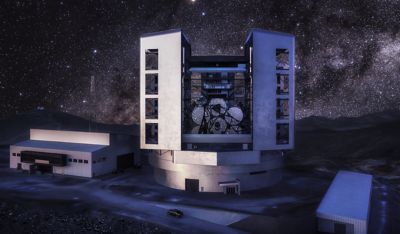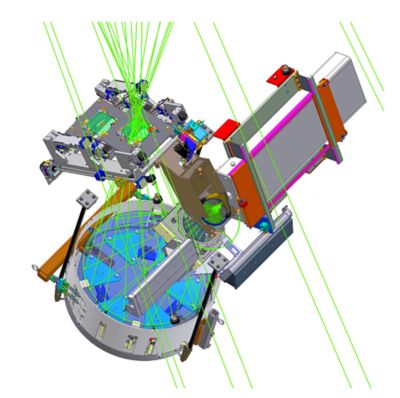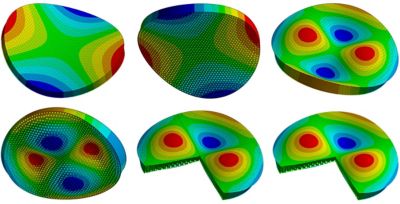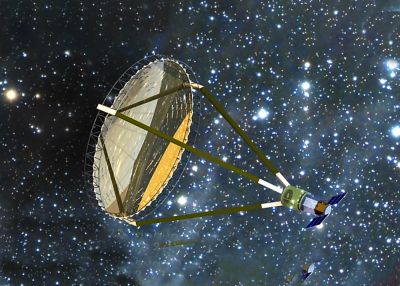-
-
学生向け無料ソフトウェアにアクセス
Ansysは次世代の技術者を支援します
学生は、世界クラスのシミュレーションソフトウェアに無料でアクセスできます。
-
今すぐAnsysに接続!
未来をデザインする
Ansysに接続して、シミュレーションが次のブレークスルーにどのように貢献できるかを確認してください。
国および地域
無料トライアル
製品およびサービス
リソースとトレーニング
当社について
Back
製品およびサービス
Ansysブログ
August 4, 2022
極度の光学エンジニアリングにより深宇宙を垣間見る
これまで数十年の間に、光科学は400年前にガリレオとニュートンが築いた基礎から大きく前進しました。これまで以上に深宇宙まで詳細に観測することに特化した新しい地上望遠鏡と宇宙望遠鏡の計画は、地球のような系外惑星を発見し、何十億年も前に銀河がどのように形成され進化したのかという疑問に答える機会を天文学者に提供することになるでしょう。こうした計画を実現するために、アリゾナ大学の研究者は、宇宙に関する私たちの知識を大きく前進させることのできる次世代の望遠鏡の光学系を設計、製作、試験する際にAnsysの構造および光学シミュレーションソフトウェアを使用しています。
アリゾナ大学は、望遠鏡に関するいくつかの主要研究開発プロジェクトの中心的役割を担っています。世界をリードする大規模な光学研究所と光科学研究施設であるWyant校(Wyant College of Optical Sciences)を擁する同大学の研究者たちは、巨大マゼラン望遠鏡のような地上システムや、現在提案されているOASIS宇宙観測衛星のような宇宙ベースの構想に電力を供給する光学部品の開発の最前線にいます。

チリのラセレナから北北東約115km(71マイル)のアタカマ砂漠に設置される予定の巨大マゼラン望遠鏡の完成構想。資料提供: 巨大マゼラン望遠鏡(GMTO社)
史上最大規模の鏡7台の建設
2020年代後半に完成予定の巨大マゼラン望遠鏡(GMT: Giant Magellan Telescope)は、これまでに建設された最大規模の地上望遠鏡の1つになります。GMTは、5大陸にまたがる13の大学と科学研究所からなる国際コンソーシアムによるプロジェクトです。構造自体は、チリのアタカマ砂漠の標高約2,500m(8,200フィート)のラスカンパナスピークに設置されます。この場所は、乾燥した気候と、光、空気、湿度からの光学干渉を軽減できる地理的な特性によって選ばれました。
GMTプロジェクトでは、十分な鮮明さで宇宙全体にわたり数十億光年を見るのに十分な量の光子を捕捉するために、主光学系を構成する7つの巨大な鏡セグメント(中心セグメントとそれを囲む6つの軸外セグメント)を建設する必要があります。集光領域のサイズにより、画像解像度は1990年に打ち上げられたハッブル宇宙望遠鏡の約10倍、2021年に打ち上げられたJames Webb宇宙望遠鏡(JWST)の約4倍になります。
GMTの各鏡セグメントは、直径8.4m(28フィート)、重量約16トンで、鋳造、研磨、テストプロセスを含め、完成までに約6年かかります。これらは世界最大の鏡であり、アリゾナ大学のRichard F. Caris Mirror Labで製造されています。最初の2つのセグメントは完成しており、セグメント3~6はすべて鋳造され、表面研磨や測定などのさまざまな段階にあります。
このような大規模な鏡を使用する際の大きな課題は、その重量と風の力によって生じる曲げです。許容される鏡の曲げは約100ナノメートル(nm)です。それを超えると像がぼやけすぎるため、剛性と重量のバランスをとることが最も重要でした。研究者たちは、まずAnsys Mechanicalを使用して、光学面の変形を予測するために鏡構造をモデル化しました。最初の構造解析が完了した後、ZemaxのSTAR(Structural, Thermal, Analysis, and Results)モジュールを使用して、Mechanicalでの有限要素法解析結果をAnsys Zemax OpticStudioに読み込み、表面の変形による各鏡セグメントの光学性能をシミュレーションしました。
完全なオプトメカニカル解析に続いて、鏡の中央構造を軽量のハニカムとして設計しました。この構造は、厚さ0.5インチの六角形パターンによる数本のリブで、厚さ1インチのガラスの表面板と背面板を保持しています。1粗面の鏡を鋳造するために、ホウケイ酸ガラスの塊を5rpmで回転する炉内の金型の上に投入します。ガラスが溶けると、金型の側面を伝って上方に流れていき、遠くの天体からの光を集束するのに必要な凹面放物線形状になります。それから3か月をかけて、炉の回転が緩やかに停止し、ガラスは室温まで冷却されます。

直径8.4mの巨大マゼラン望遠鏡(GMT)軸外セグメント表面形状測定用のコンピュータ生成ホログラム(CGH)ベースの干渉分光法構成。
ガラスが冷却されると、次は、要求される光学品質まで鏡を研磨して、目的の形状を達成するための面形状精度を設定する長い工程に移ります。それには、受信する光の波長のわずかな割合の精度が必要です。表面は、理想的な軸外(中心セグメントの場合は軸上)の放物面と誤差25nm以内(髪の毛の幅の1000分の1未満)で一致する必要があります。表面は非球面であるため、形状を非常に細かく制御する必要がありました。鏡表面の異なる位置で、2つの異なるタイプの研磨ツールを使用し、異なるスケールの高い箇所を選択して、研磨材を用いて分子単位でガラスをゆっくりと除去しました。
この正確な光学面形状精度を設定するには、決定論的な手法が不可欠になります。通常は1週間かかる研磨と面形状精度の設定の工程に進む前に、ガラス材料の除去をモデル化、シミュレーション、最適化、予測できなかった場合には、適切な場所から適切な量の材料が除去されているかどうかを把握できません。そうなると、各鏡セグメントの製造期間は6年をはるかに超え、プログラムはさらに数年、場合によっては数十年遅れることになります。
このような試行錯誤の手法を避けるために、各研磨工程の後に、レーザー干渉分光法と可視偏向計を使用して、鏡の表面形状を測定しました。次に、Ansys Mechanicalや他の構造解析ツールを使用して、測定中の表面の重力変形と熱変形をモデル化し、予測された変形を測定面誤差で補正しました。これにより、オプトメカニカル表面曲げ効果と混同することなく、適切な光学面誤差の補正を行うための光学面形状精度の設定を数回にわたって実行することにしました。
面形状精度の設定や研磨を開始する前は、表面の精度は約30μm(30,000nm)以内であり、目標精度である25nmからは、まだ3桁ほど離れています。シミュレーションを使用したことで研磨プロセスは大幅に改善され、特定の表面精度値を達成するために必要な期間を4分の1に短縮できました。セグメント1には、2400nmから320nmの精度向上に約300日の研磨を要しました。セグメント2については、同じ結果をわずか70日で達成し、次のセグメントではさらに時間を短縮できると予想されています。2

8.4mのGMT軸外主鏡セグメントの2つの曲げモード形状を示すシミュレーション結果(各種ビュー)
OASIS宇宙観測衛星: 水は存在するか
宇宙望遠鏡の実用限界の1つは、光学系のサイズと重量です。風や光の汚染などの問題は解消できますが、すべての部品をロケット内に収容して軌道に乗せる必要があります。James Webb宇宙望遠鏡の鏡の全直径は6.5mです。これは、GMTの主鏡1枚よりは小さいものの、18個の六角形セグメントを折り畳んだ状態で打ち上げる必要がありました。はるかに大きな光学系を組み込んだ物体を打ち上げるには、根本的に異なる材料を使用しなければなりません。

サブミリメートルから遠赤外線までを観測するOASIS宇宙観測衛星のテラヘルツ望遠鏡の3Dレンダリング画像
最近発表されたNASAの中型探査機の機会通知に応えて、金属高分子膜で作られた主鏡(アンテナ)を備えた宇宙観測衛星であるOASIS(Orbiting Astronomical Satellite for Investigating Stellar Systems)望遠鏡の開発が進められています。これは、実質的に巨大なマイラーバルーンです。宇宙船から完全に展開されると、反射体は最大20メートル(66フィート)まで膨らみます。OASISは、能動光学や適応光学技術とともに、遠赤外線スペクトル(約660μmから63μm)においてテラヘルツ周波数で高解像度の観測を実現するように設計されます。これにより、局所的な小惑星や、他の星系の惑星や衛星の両方で水を探すことができます。
主鏡にはインフレータブルな材料を使用しているため、その形状は圧力の関数であり、光学設計にとって独自の課題となります。アリゾナ大学の研究者たちは、独自に開発した解析モデルを使用して、パラメトリック解析空間を評価し、アンテナの表面プロファイルの変化を補正するために必要な副鏡などの望遠鏡光学系の位置とサイズを決定しました。これと並行して、Zemax OpticStudioを使用してレイトレーシング解析を実行し、アンテナの光子収集領域を予測しました。OpticStudioの結果により、膜の解析モデルと数値モデルのどちらもインフレータブル光学面の光学設計パラメータを正確に予測するのに適していることが確認されました。3
NASAがこのプロジェクトを選択した場合、OASISは2028年に打ち上げられ、L2ラグランジュ点周辺の軌道で運用される予定です。これは、太陽および地球からの重力と衛星の動きでバランスをとることができる衛星の位置の1つです。L2点は、太陽から地球までの距離よりも、さらに約100万マイル遠く離れており、JWSTの天体近傍でもあります。さらに多くのケースが検討され、テクノロジーの開発が積極的に行われている中で、他の軌道も検討されています。

OASIS観測帯域1の設計モデルのインフレータブル光学設計解析空間のコンター図。M2およびM3鏡の有効光子収集面積と直径は、A1曲率半径と入射瞳径(EPD)の関数としてプロットされる。
展開までのカウントダウン
GMTおよびOASISの開発に取り組んでいるアリゾナ大学のチームメンバーの多くは、ここ30年間のハッブル計画の成功と、それが明らかにした有名な深宇宙の画像に触発されています。ハッブル宇宙望遠鏡から送られてきた画像は、それまでの数十年にわたる光科学とエンジニアリングによって可能となった宇宙望遠鏡の打ち上げと運用によって実現されたものです。彼らは、2020年代後半の両プロジェクトの実現に向けて、同じような画像を次の世代に贈りたいという共通の夢を持って研究に取り組んでいます。
参考文献
- B. Martin and D. Kim, “How do you build a mirror for one of the world’s biggest telescopes?,” The Conversation, 15 Jan. 2016, theconversation.com/how-do-you-build-a-mirror-for-one-of-the-worlds-biggest-telescopes-49927. Accessed 15 Apr. 2022.
- H. Martin et al., “Manufacture of primary mirror segments for the Giant Magellan Telescope,” Proc. SPIE 10706, Advances in Optical and Mechanical Technologies for Telescopes and Instrumentation III, 107060V (2018).
- S. Sirsi et al., “Parametric design study of the Orbiting Astronomical Satellite for Investigating Stellar Systems (OASIS) space telescope,” Proc. SPIE 11820, Astronomical Optics: Design, Manufacture, and Test of Space and Ground Systems III, 118200Q (2021).